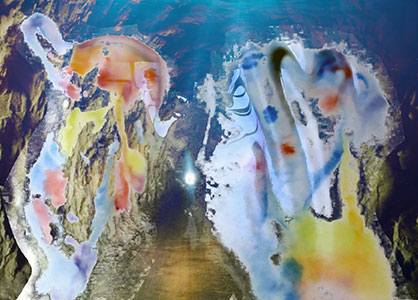GALLERY EVENTS
Interruptions: Libby Heaney
Interview between Libby Heaney and Aoife Elston
Aoife: Your work stands at the intersection of science and art, which could be thought of as binary oppositions. How do you feel that they work together in your practice, do you feel that they work cohesively?
Libby: Art and science are different expressions of knowledge. Science aims to make objective statements about the world by averaging out our subjective interpretation - hence science should be repeatable and verified in many contexts. Art, on the other hand, deals with meaning, subjectivities, poetry, illusion and in most instances tries to avoid being didactic. These statements about art and science might seem to be opposites. However, in my practice, I draw on concepts from quantum physics, which is an entirely different way of seeing the world. Quantum theory posits plurality and entanglements over individualism and has a special role for subjectivities too. Seeing the world through quantum theory fits well with art so I think the two areas are somewhat cohesive in my work while also pointing out moments of dissonance or glitches where the two spheres move apart.
A: You have a background in science - a PhD in quantum information science - and you now work with emerging technology, including AI and VR. How did you begin your journey as an artist? Did you always know that you wanted to pursue a fine art practice?
L: Yes I always wanted to pursue a fine art practice, but I think because I come from a working class background, my teachers and family encouraged me to take a degree in something "I could earn some money from". So I studied quantum physics, but in the back of my mind I always knew I'd make the switch and retrain as an artist when I could financially manage it.
Having worked at the forefront of research in quantum computing (University of Oxford/National University of Singapore), I was really worried about the lack of critical discourse in the field - back then no one was discussing the ethical, societal, political etc impacts of these powerful new tools that were being developed. There are hardly any discussions about the impacts of quantum computing now. Moving into art, in some sense, enables me to explore these ideas from a wider viewpoint.

A: In both parts of Agency is the Ability to Act, there is a strong emphasis on wording and creative writing. Can you tell us about your writing process and how important it is to your work?
L: I was fortunate to have some mentoring for writing from the amazing artist Sophie Jung. I was trying to understand how to write in different voices - one a more formal jargon laden rational voice and then the other a less patriarchal irrational voice. For Agency is the Ability to Act (part 2) I wrote out what I wanted to say in plain simple English. I then thought of rhyming words and other words that sounded good with the simple version - even if they didn't make sense semantically. Finally, I rewrote the whole thing using the plain English version as a scaffold and the other words as decoration. In the end I think there's a balance between content and form.
A: In Agency is the Ability to Act (part 2), there is a strong narrative voice, who or what is this? And how does it relate to the subject of this piece.
L: In both parts the voice is the machine, the app and/or the developers behind the app. The voice of the black box speaking its desires, the algorithms innermost thoughts.
Aoife Elston is currently studying BA Fine Art and Art History at Manchester School of Art and is a current member of the Holden Gallery’s Curatorial Collective.

